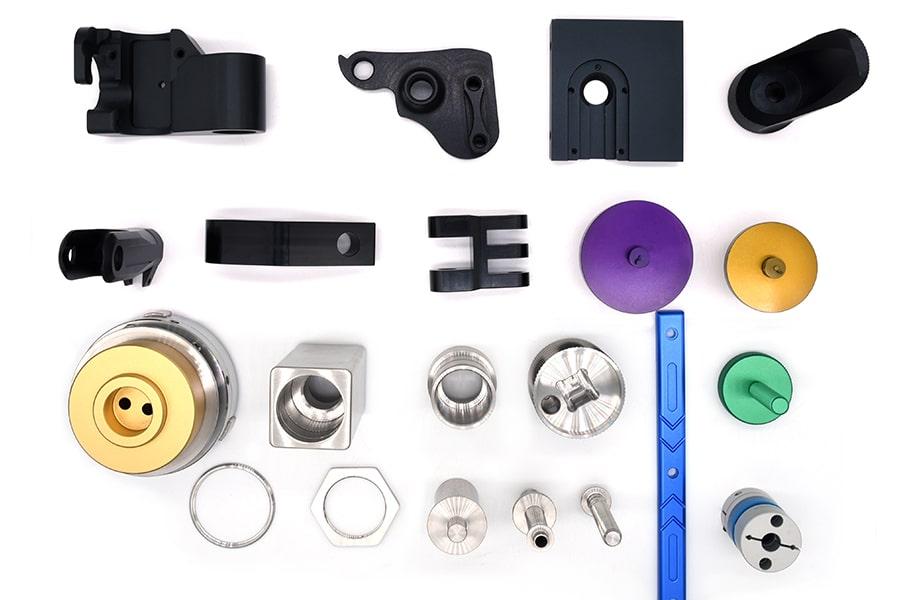Metal part manufacturing refers to the process of creating finished components or parts from metal materials. There are several techniques and processes involved in metal part manufacturing, each offering unique advantages and suitable for different applications. Here are some common methods used in metal part manufacturing:
- Casting: Casting is a process where molten metal is poured into a mold and allowed to solidify, taking the shape of the mold cavity. It can be done using various methods such as sand casting, investment casting, die casting, or centrifugal casting. Casting is suitable for producing complex shapes and large quantities of metal parts.
- Machining: Machining involves the removal of material from a metal workpiece using cutting tools to create the desired shape. Common machining processes include turning, milling, drilling, and grinding. Machining provides high precision and allows for intricate details, making it suitable for producing custom or low-volume metal parts.
- Sheet Metal Fabrication: Sheet metal fabrication involves forming, cutting, and assembling metal sheets to create a final product. Processes like bending, laser cutting, punching, and welding are commonly used. Sheet metal fabrication is widely used in industries such as automotive, electronics, and construction.
- Additive Manufacturing: Also known as 3D printing, additive manufacturing builds metal parts layer by layer using metal powders or filaments. It offers design freedom, complex geometries, and the ability to create prototypes or small batches without the need for complex tooling. Metal additive manufacturing techniques include selective laser melting (SLM) and electron beam melting (EBM).
- Forging: Forging involves the shaping of metal by applying compressive forces to a heated workpiece, typically using a die or hammer. It is commonly used for producing strong and durable metal parts, such as automotive components, aerospace parts, and tools.
- Extrusion: Extrusion is a process where a metal billet is forced through a shaped die to create continuous profiles or lengths of the desired shape. It is commonly used for producing linear or continuous metal parts, such as rods, tubes, and structural components.
- Stamping: Stamping involves the use of a die to shape and form metal sheets or strips. The process applies pressure to the metal to create complex geometries, such as brackets, clips, or automotive body panels.
- Welding and Joining: Welding and joining processes involve fusing or joining metal parts together to create a single component. Techniques such as arc welding, resistance welding, or brazing are used to create strong and durable bonds between metal parts.
Each metal part manufacturing method has its own advantages, limitations, and applications. The selection of the appropriate metal part manufacturing method depends on factors such as part complexity, required accuracy, desired strength, material properties, production volume, and cost considerations.
CNC manufacturing
CNC (Computer Numerical Control) manufacturing, also known as CNC machining, is a process that utilizes computer-controlled machines to produce precise and complex parts from various materials. It involves the use of automated tools and machinery guided by pre-programmed instructions to perform specific manufacturing operations. Here are the key aspects of CNC manufacturing:
- CAD Design: The process begins with the creation of a detailed 3D model using computer-aided design (CAD) software. The model defines the dimensions, geometries, and features of the desired part.
- CAM Programming: The CAD model is then imported into computer-aided manufacturing (CAM) software, where toolpaths and machining instructions are generated. The CAM software translates the design into machine-readable code, typically G-code, which the CNC machine will follow.
- CNC Machine Setup: The CNC machine is set up for the specific manufacturing job. This involves securing the raw material, loading the required cutting tools, and configuring the machine parameters such as cutting speed, feed rate, and tool changes.
- CNC Machining Operations: The CNC machine executes the programmed instructions, performing various machining operations based on the design requirements. Common operations include milling, turning, drilling, tapping, reaming, and threading. These operations shape and remove material from the workpiece to create the desired part.
- Tool Changes and Automation: CNC machines often have multiple tool stations or automatic tool changers, allowing for efficient tool changes during machining. This enables the machine to use different tools or perform multiple operations without manual intervention, increasing productivity and reducing downtime.
- Quality Control: Throughout the machining process, quality control measures are implemented to ensure the accuracy and precision of the manufactured parts. This may include in-process inspections, dimensional checks, surface finish evaluations, and final inspection of finished parts.
- Post-Machining Operations: After the CNC machining process is complete, additional operations such as deburring, cleaning, polishing, or surface treatments may be performed to remove any sharp edges, improve surface finishes, or add protective coatings.
CNC manufacturing offers several advantages, including high precision, repeatability, versatility, and the ability to work with a wide range of materials. It is commonly used in various industries, including automotive, aerospace, electronics, medical, and manufacturing. CNC machines can produce complex parts with tight tolerances, allowing for customization, rapid prototyping, and efficient production of both small batches and large-scale manufacturing.
Xielifeng Tech is a reliable metal part manufacturer, we provide cnc machining, sheet metal, die casting, etc, services to custtomize metal parts.

